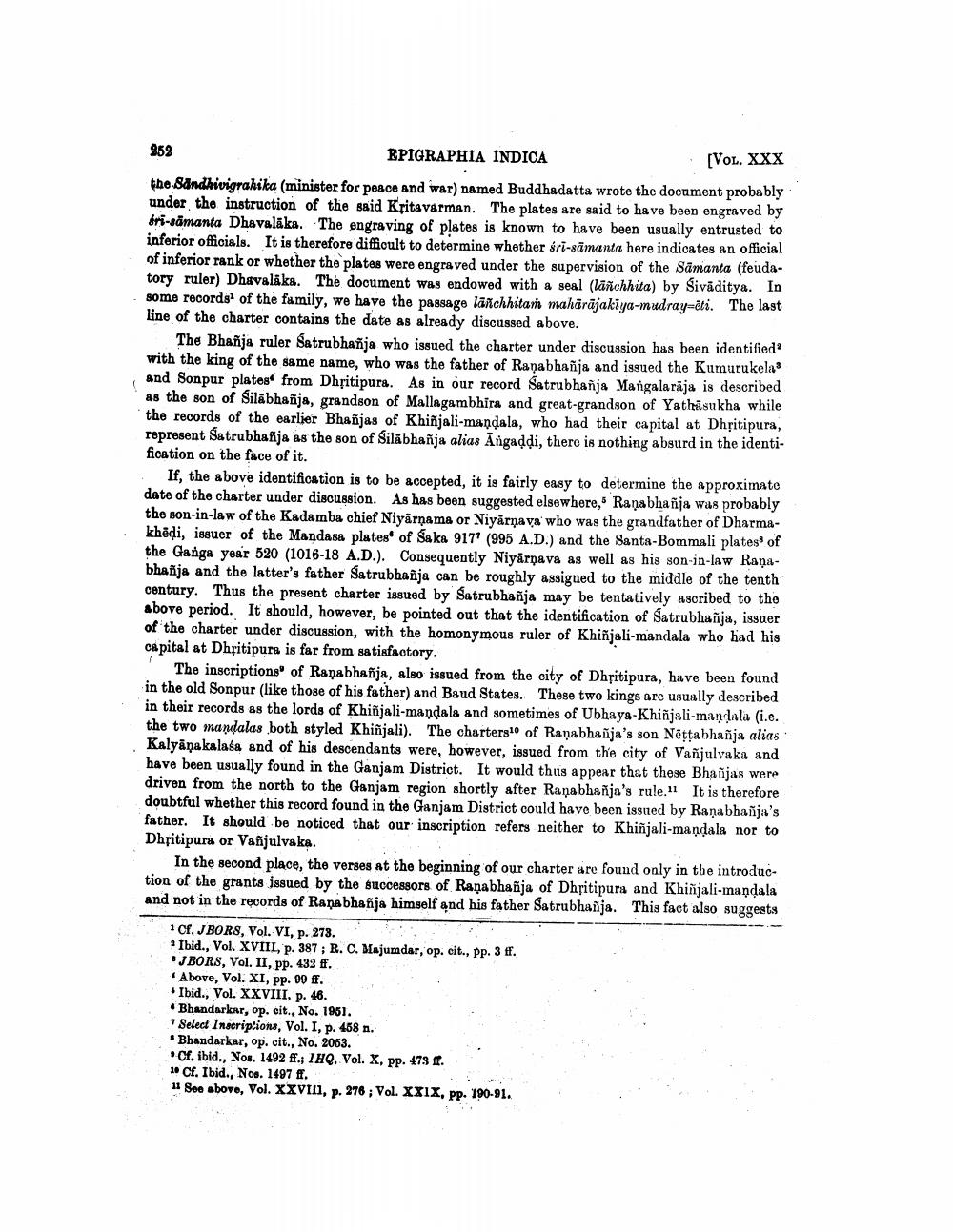________________
962
EPIGRAPHIA INDICA
[VOL. XXX
the Sundhivigrahika (minister for peace and war) named Buddhadatta wrote the document probably under the instruction of the said Kritavarman. The plates are said to have been engraved by fri-sämanta Dhavalāka. The engraving of plates is known to have been usually entrusted to inferior officials. It is therefore difficult to determine whether sri-sämanta here indicates an official of inferior rank or whether the plates were engraved under the supervision of the Samanta (feudatory ruler) Dhavalāka. The document was endowed with a seal (lāñchhita) by Sivāditya. In some records of the family, we have the passage lāschhitan mahārājakiya-mudraymēti. The last line of the charter contains the date as already discussed above.
The Bhanja ruler Satrubhanja who issued the charter under discussion has been identified with the king of the same name, who was the father of Ranabhañja and issued the Kumurukela: and Sonpur platest from Dhțitipura. As in our record Satrubhanja Mangalarāja is described as the son of Silābhañja, grandson of Mallagambhira and great-grandson of Yathāsukha while the records of the earlier Bhañjas of Khiñjali-mandala, who had their capital at Dhșitipura, represent Satrubhañja as the son of Silābhañja alias Angaddi, there is nothing absurd in the identification on the face of it.
If, the above identification is to be accepted, it is fairly easy to determine the approximate date of the charter under discussion. As has been suggested elsewhere, Ranabhañja was probably the son-in-law of the Kadamba chief Niyārnama or Niyârnava who was the grandfather of Dharmakhēdi, issuer of the Mandasa plates of Saka 917° (995 A.D.) and the Santa-Bommali plates of the Ganga year 520 (1016-18 A.D.). Consequently Niyārņava as well as his son-in-law Raņabhañja and the latter's father Satrubhañja can be roughly assigned to the middle of the tenth century. Thus the present charter issued by Satrubhañja may be tentatively ascribed to the above period. It should, however, be pointed out that the identification of Satrubhanja, issuer of the charter under discussion, with the homonymous ruler of Khiñjali-mandala who had his capital at Dhfitipura is far from satisfactory.
The inscriptions of Ranabhanja, also issued from the city of Dhritipura, have been found in the old Sonpur (like those of his father) and Baud States. These two kings are usually described in their records as the lords of Khiñjali-mandala and sometimes of Ubhaya-Khiñjali-mandala (i.e. the two mandalas both styled Khiñjali). The charterglo of Ranabhañja's son Néttabhañja alias Kalyāņa kalasa and of his descendants were, however, issued from the city of Vañjulvaka and have been usually found in the Ganjam District. It would thus appear that these Bhañjas were driven from the north to the Ganjam region shortly after Ranabhanja's rule.11 It is therefore doubtful whether this record found in the Ganjam District could have been issued by Ranabhañja's father. It should be noticed that our inscription refers neither to Khiñjali-mandala nor to Dhritipura or Vañjulvaka.
In the second place, the verses at the beginning of our charter are found only in the introduction of the grants issued by the successors of Ranabhañja of Dhritipura and Khiñjali-mandala and not in the records of Ranabhafija himself and his father Satrubhañja. This fact also suggests
1 Cf. J BORS, Vol. VI, p. 273. a Ibid., Vol. XVIII, p. 387; R. C. Majumdar, op. cit., pp. 3 t. *J BORS, Vol. II, pp. 432 ff. Above, Vol. XI, pp. 99 ff. Ibid., Vol. XXVIII, p. 46. • Bhandarkar, op. cit., No. 1951.
Select Inscriptions, Vol. I, p. 458 n. Bhandarkar, op. cit., No. 2063.
Cf. ibid., Nos. 1492 ff.; 1HQ, Vol. X, PP. 473 ff. 1. Cf. Ibid., Nos. 1497 ff. 11 Soo sbovo, Vol. XXVIII, p. 278 ; Vol. XXIX, pp. 190-91.




